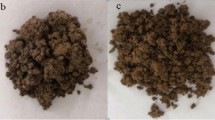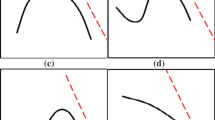Abstract
The effect of native palygorskite clay and that modified with dodecyltrimethylammonium chloride on the degradation of oil products in an oligotrophic peat soil under complete flooding at the application of lime and mineral fertilizers has been studied under laboratory conditions. It has been shown that the incubation of oil-contaminated soil with unmodified clay and fertilizers at the application of lime under complete flooding with water affects the dynamics of pH and Eh and slows the development of reducing conditions compared to the use of clay without fertilizers. The addition of organoclay under similar conditions favors the formation of potential-determining system with a high redox capacity, which is capable of retaining the potential on a level of 100–200 mV at pH ∼ 7 for two months. It has been found that, under the experimental conditions, unmodified and modified clay, which has no toxic effect on the bacterial complex, does not increase the biodegradation efficiency of oil products in the oligotrophic peat soil compared to the experimental treatments without clay addition. Possible reasons for no positive effect of palygorskite clay on the biodegradation rate of oil products under experimental conditions have been analyzed.
Similar content being viewed by others
References
N. A. Avetov, N. K. Shvedchikova, and E. A. Shishkonakova, “Plants-phytomeliorants prospective for reclamation of disturbed wetlands in the Central Ob region,” in Biological Resources and Nature Management (Defis, Surgut, 2008), Vol. 11, pp. 241–251.
L. P. Voronina and V. A. Terekhova, Use of Phytotesting for Ecological Monitoring (Dobroe Slovo, Moscow, 2014) [in Russian].
A. V. Golovchenko, E. Yu. Tikhonova, and D. G. Zvyagintsev, “Abundance, biomass, structure, and activity of the microbial complexes of minerotrophic and ombrotrophic peatlands,” Microbiology (Moscow) 76, 711–719 (2007).
V. N. Efimov, Peat Soils and Their Fertility (Agropromizdat, Leningrad, 1986) [in Russian].
S. A. Illarionov, Ecological Aspects of Remediation of Oil-Polluted Soils (Ural Branch, Russian Academy of Sciences, Yekaterinburg, 2004) [in Russian].
A. P. Krasavin and I. V. Kataeva, “Biotechnological restoration of soil fertility in difficult ecological conditions,” Proceedings of the International Conference “Biological Reclamation of Disturbed Lands” (Ural Branch, Russian Academy of Sciences, Yekaterinburg, 2003), pp. 231–238
Crystallographic and crystallochemical database of minerals and their structural analogs, 2016. http:// database.iem.ac.ru/mincryst/rus/.
V. N. Kudeyarov, “Nitrogen cycle and nitrous oxide production,” Eurasian Soil Sci. 32, 892–901 (1999).
L. V. Lysak, T. G. Dobrovol’skaya, and I. N. Skvortsova, Evaluation of Bacterial Diversity of Soils and Identification of Soil Bacteria (MAKS Press, Moscow, 2003) [in Russian].
L. V. Lysak, E. V. Lapygina, I. A. Konova, and D. G. Zvyagintsev, “Definition of the physiological condition of bacteria in soil by means of luminescent dye L7012,” Biol. Bull. 36, 639–642 (2009).
I. I. Lytkin, “Agroecological role of fertilizers and lime in agrocenoses of peat soils during their cultivation,” Agrokhimiya, No. 5, 17–26 (2007).
Manual on Soil Microbiology and Biochemistry, Ed. by D. G. Zvyagintsev (Moscow State Univ., Moscow, 1991) [in Russian].
V. A. Myazin, Candidate’s Dissertation in Engineering (Apatity, 2014).
V. V. Nasedkin, N. M. Boeva, I. A. Garbuzova, M. V. Kovalchuk, and A. L. Vasiliev, “The crystal structure and chemistry of several palygorskite samples with different geneses,” Crystallogr. Rep. 54, 884–900 (2009).
V. V. Nasedkin, K. V. Demidenok, N. M. Boeva, P. E. Belousov, and A. L. Vasil’ev, “Organoclays: production and main purpose,” Aktual’n. Innovatsionnye Issled. Nauka Prakt., No. 3, 1–19 (2012).
PND F 16.1;2.2.22-98: Measurement of Mass Fraction of Petroleum Products in Mineral, Organic, Organo-Mineral Soils and Bottom Sediments by IR Spectrometry (Moscow, 1998) [in Russian].
V. I. Savich, “Soil fertility improvement by regulation of redox status,” Dokl. Vses. Akad. S-kh. Nauk im. V.I. Lenina, No. 6, 12–15 (1988).
L. A. Salanginas, A. N. Satubaldin, and A. V. Belogurova, “The effect of the application of siderate cultures for the biological reclamation of oil-polluted lands in the Urals and Western Siberia,” Proceedings of International Conference “Biological Recultivation of Disturbed Lands” (Yekaterinburg, 2003), pp. 427–434.
T. A. Sokolova, T. Ya. Trofimov, I. I. Tolpeshta, and T. Ya. Dronova, “Experimental study of the interaction between sphagnum peat and drilling mud,” Eurasian Soil Sci. 38, 324–332 (2005).
N. P. Solntseva, Oil Production and Geochemistry of Natural Landscapes (Moscow State Univ., Moscow, 1998) [in Russian].
Yu. I. Tarasevich and F. D. Ovcharenko, Adsorption on Clay Minerals (Naukova Dumka, Kiev, 1975) [in Russian].
V. A. Terekhova, O. S. Yakimenko, L. P. Voronina, and K. A. Kydralieva, Measurement of the Biological Activity of Humic Substances by Phytotesting (Fitoskan) (Dobroe Slovo, Moscow, 2014) [in Russian].
I. I. Tolpeshta, S. Ya. Trofimov, M. I. Erkenova, T. A. Sokolova, A. L. Stepanov, L. V. Lysak, and A. M. Lobanenkov, “Laboratory simulation of the successive aerobic and anaerobic degradation of oil products in oil-contaminated high-moor peat,” Eurasian Soil Sci. 48, 314–324 (2015).
Physical and Chemical Analysis of Soils (Moscow State Univ., Moscow, 1980) [in Russian].
N. Takeno, Atlas of Eh-pH Diagrams. Intercomparison of Thermodynamic Databases, Geological Survey of Japan Open File Report No. 419 (National Institute of Advanced Industrial Science, Technology Research Center for Deep Geological Environments, Tsukuba, 2005).
M. A. Baig and K. R. Tice, “Identification and distribution of palygorskite in a Petrocalcic Paleargid,” Geol. Bull. Univ. Peshawar 30, 107–117 (1997).
R. M. Barrer, “Shape-selective sorbents based on clay minerals: a review,” Clays Clay Miner. 37 (5), 385–395 (1989).
Handbook of Clay Science, Ed. by F. Bergaya, B. K. G. Theng, and G. Lagaly (Elsevier, Amsterdam, 2006).
H. L. Ehrlich, Geomicrobiology (Marcel Dekker, New York, 2002).
S. Froehner, E. C. Luz, and M. Maceno, “Enhanced biodegradation of naphthalene and anthracene by modified vermiculite mixed with soil,” Water Air Soil Pollut. 202, 169–177 (2009).
S. Froehner, R. F. Martins, W. Furukawa, and M. R. Errera, “Water remediation by adsorption on phenol onto hydrophobic modified clay,” Water Air Soil Pollut. 199 (1), 107–113 (2009).
H. He, Q. Zhou, W. N. Martens, T. J. Kloprogge, P. Yuan, Y. Xi, J. Zhu, and R. L. Frost, “Microstructure of HDMA+-modified montmorillonite and its influence on sorption characteristics,” Clays Clay Miner. 54 (6), 689–696 (2006).
W. F. Jaynes and S. A. Boyd, “Hydrophobicity of siloxane surfaces in smectites as revealed by aromatic hydrocarbon adsorption from water,” Clays Clay Miner. 39 (4), 428–436 (1991).
G. Lagaly, M. Gonzalez, and A. Weiss, “Problems in layer-charge determination on montmorillonites,” Clay Miner. 11, 173–187 (1976).
G. Lagaly, M. Ogawa, and I. Dekany, “Clay mineral organic interaction, in Handbook of Clay Science, Ed. by F. Bergaya, B. K. G. Theng, and G. Lagaly (Elsevier, Amsterdam, 2006), Vol. 1, pp. 309–377.
Z. Li, C. A. Willms, and K. Kniola, “Removal of anionic contaminants using surfactant-modified palygorskite and sepiolite,” Clays Clay Miner. 51 (4), 445–451 (2003).
P. A. Lock and N. T. Skipper, “Computer simulation of the structure and dynamics of phenol in sodium montmorillonite hydrates,” Eur. J. Soil Sci. 58, 958–966 (2007).
S. V. Mohan, T. Kisa, T. Ohkuma, R. A. Kanaly, and Y. Shimizu, “Bioremediation technologies for treatment of PAH-contaminated soil and strategies to enhance process efficiency,” Rev. Environ. Sci. Biotechnol. 5, 347–374 (2006).
D. M. Moore and R. C. Reynolds, X-Ray Diffraction and the Identification and Analysis of Clay Minerals (Oxford University Press, Oxford, 1989).
S. Mueller, K. U. Totsche, and I. Koegel-Knabner, “Sorption of polycyclic aromatic hydrocarbons to mineral surfaces,” Eur. J. Soil Sci. 58, 918–931 (2007).
Y. Park, G. A. Ayoko, and R. L. Frost, “Synthesis and characterization of organoclays using single alkyl chain cationic surfactants—applications for water treatment,” The 21st Australian Clay Minerals Conference, Extended Abstracts (Brisbane, 2010), pp. 91–92.
Y. Park, R. L. Frost, G. A. Ayoko, and D. L. Morgan, “Adsorption of p-nitrophenol on organoclays,” J. Therm. Anal. Calorim. 111, 41–47 (2013).
R. R. Tiwari, K. C. Khilar, and U. Natarajan, “Synthesis and characterization of novel organo-montmorillonites,” Appl. Clay Sci. 38, 203–208 (2008).
B. Sarkar, M. Megharaj, Y. Xi, and R. Naidu, “Surface charge characteristics of organo-palygorskites and adsorption of p-nitrophenol in flow-through reactor system,” Chem. Eng. J. 185–186, 35–43 (2012).
B. Sarkar, Y. Xi, M. Megharaj, G. Krishnamurti, and R. Naidu, “Preparation and characterization of organopalygorskites and their application for p-nitrophenol adsorption,” The 21st Australian Clay Minerals Conference, Extended Abstracts (Brisbane, 2010), pp. 141–143.
H. Shariatmadarj, A. R. Mermut, and M. B. Benke, “Sorption of selected cationic and neutral organic molecules on palygorskite and sepiolite,” Clays Clay Miner. 47 (1), 44–53 (1999).
A. D. Site, “Factors affecting sorption of organic compounds in natural sorbent/water systems and sorption coefficients for selected pollutants. A review,” J. Phys. Chem. Ref. Data 30 (1), 187–439 (2001).
J. A. Smith, P. R. Jaffe, and C. T. Chlou, “Effect of ten quaternary ammonium cations on tetrachloromethane sorption to clay from water,” Environ. Sci. Technol. 24, 1167–1172 (1990).
S. Suthersan, Remediation Engineering: Design Concepts (CRC, Boca Raton, Fl, 1999).
U. Tezel and S. G. Pavlostathis, “Quaternary ammonium disinfectants: microbial adaptation, degradation and ecology,” Curr. Opin. Biotechnol. 33, 296–304 (2015).
U. Tezel, J. A. Pierson, and S. G. Pavlostathis, “Effect of polyelectrolytes and quaternary ammonium compounds on the anaerobic biological treatment of poultry processing wastewater,” Water Res. 41, 1334–1342 (2007).
U. C. Ugochukwu, M. D. Jones, I. M. Head, D. A. C. Manning, and C. I. Fialips, “Biodegradation of crude oil saturated fraction supported on clays,” Biodegradation 25 (1), 153–165 (2014).
U. C. Ugochukwu, M. D. Jones, I. M. Head, D. A. C. Manning, and C. I. Fialips, “Biodegradation and adsorption of crude oil hydrocarbons supported on “homoionic” montmorillonite clay minerals,” Appl. Clay Sci. 87, 81–86 (2014).
U. C. Ugochukwu, D. A. C. Manning, and C. I. Fialips, “Microbial degradation of crude oil hydrocarbons on organoclay minerals,” J. Environ. Manage. 144 (1), 197–202 (2014).
L. N. Warr, J. N. Perdrial, M.-C. Lett, A. Heinrich- Salmeron, and M. Khodja, “Clay mineral-enhanced bioremediation of marine oil pollution,” Appl. Clay Sci. 46, 337–345 (2009).
S. C. Whalen, “Biogeochemistry of methane exchange between natural wetlands and the atmosphere,” Environ. Eng. Sci. 22 (1), 73–94 (2005).
Y. Xi, M. Mallavarapu, and R. Naidu, “Adsorption of the herbicide 2,4-D on organo-palygorskite,” Appl. Clay Sci. 49, 255–261 (2010).
J. Zhang, D. Cai, G. Zhang, C. Cai, C. Zhang, G. Qiu, K. Zheng, and Z. Wu, “Adsorption of methylene blue from aqueous solution onto multiparous palygorskite modified by ion beam bombardment: Effect of contact time, temperature, pH and ionic strength,” Appl. Clay Sci. 83–84, 137–143 (2013).
L. Zhang, B. Zhang, T. Wu, D. Sun, and Y. Li, “Adsorption behavior and mechanism of chlorophenols on to organoclays in aqueous solution,” Colloids Surf., A 484, 118–129 (2015).
Author information
Authors and Affiliations
Corresponding author
Additional information
Original Russian Text © I.I. Tolpeshta, M.I. Erkenova, 2018, published in Pochvovedenie, 2018, No. 2, pp. 229–242.
Rights and permissions
About this article
Cite this article
Tolpeshta, I.I., Erkenova, M.I. Effect of Palygorskite Clay, Fertilizers, and Lime on the Degradation of Oil Products in Oligotrophic Peat Soil under Laboratory Experimental Conditions. Eurasian Soil Sc. 51, 229–240 (2018). https://doi.org/10.1134/S1064229318020126
Received:
Published:
Issue Date:
DOI: https://doi.org/10.1134/S1064229318020126




